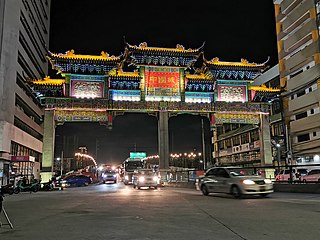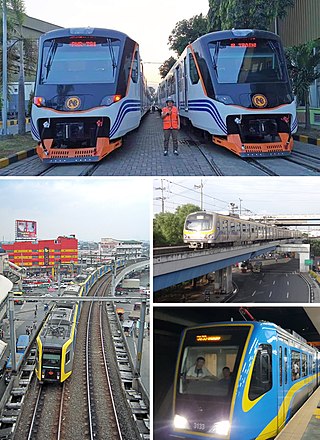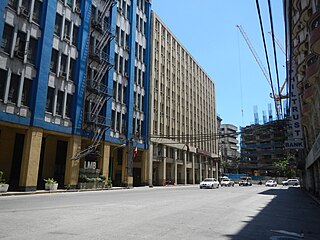
Transportation in the Philippines covers the transportation methods within this archipelagic nation of over 7,500 islands. From a previously underdeveloped state of transportation, the government of the Philippines has been improving transportation through various direct infrastructure projects, and these include an increase in air, sea, road, and rail transportation and transport hubs.

Manila, officially the City of Manila, is the capital and second-most populous city of the Philippines. Located on the eastern shore of Manila Bay on the island of Luzon, it is classified as a highly urbanized city. As of 2019, it is the world's most densely populated city proper. It was the first chartered city in the country, and was designated as such by the Philippine Commission Act No. 183 on July 31, 1901. It became autonomous with the passage of Republic Act No. 409, "The Revised Charter of the City of Manila", on June 18, 1949. Manila is considered to be part of the world's original set of global cities because its commercial networks were the first to extend across the Pacific Ocean and connect Asia with the Spanish Americas through the galleon trade; when this was accomplished, it was the first time an uninterrupted chain of trade routes circling the planet had been established. Manila is among the most-populous and fastest-growing cities in Southeast Asia.

Davao Region, formerly called Southern Mindanao, is an administrative region in the Philippines, designated as Region XI. It is situated at the southeastern portion of Mindanao and comprises five provinces: Davao de Oro, Davao del Norte, Davao del Sur, Davao Oriental and Davao Occidental.

Chinatowns in Asia are widespread with a large concentration of overseas Chinese in East Asia and Southeast Asia and ethnic Chinese whose ancestors came from southern China—particularly the provinces of Guangdong, Fujian, and Hainan—and settled in countries such as Brunei, Cambodia, East Timor, Indonesia, India, Laos, Malaysia, Myanmar, the Philippines, Singapore, Sri Lanka, Thailand, Vietnam, Japan and Korea centuries ago—starting as early as the Tang dynasty, but mostly notably in the 17th through the 19th centuries, and well into the 20th century. Today the Chinese diaspora in Asia is primarily concentrated in Southeast Asia; however, the legacy of the once widespread overseas Chinese communities in Asia is evident in the many Chinatowns found across East, South and Southeast Asia.

Japantown (日本人街) is a common name for Japanese communities in cities and towns outside Japan. Alternatively, a Japantown may be called J-town, Little Tokyo or Nihonmachi (日本町), the first two being common names for Japantown, San Francisco, Japantown, San Jose and Little Tokyo, Los Angeles.

Binondo is a district in Manila and is referred to as the city's Chinatown. Its influence extends beyond to the places of Quiapo, Santa Cruz, San Nicolas and Tondo. It is the oldest Chinatown in the world, established in 1594 by the Spaniards as a settlement near Intramuros but across the Pasig River for Catholic Chinese, it was positioned so that colonial rulers could keep a close eye on their migrant subjects. It was already a hub of Chinese commerce even before the Spanish colonial period. Binondo is the center of commerce and trade of Manila, where all types of business run by Filipino-Chinese thrive.

Rail transportation in the Philippines is currently used mostly to transport passengers within Metro Manila and provinces of Laguna and Quezon, as well as a commuter service in the Bicol Region. Freight transport services once operated in the country, but these services were halted. However, there are plans to restore old freight services and build new lines. From a peak of 1,100 kilometers (680 mi), the country currently has a railway footprint of 533.14 kilometers (331.28 mi), of which only 129.85 kilometers (80.69 mi) are operational as of 2023, including all the urban rail lines. World War II, natural calamities, underspending, and neglect have all contributed to the decline of the Philippine railway network. In the 2019 Global Competitiveness Report, the Philippines has the lowest efficiency score among other Asian countries in terms of efficiency of train services, receiving a score of 2.4, and ranking 86th out of 101 countries globally. The government is currently expanding the railway network up to 1,900 kilometers (1,200 mi) by 2022 through numerous projects.

The Pan-Philippine Highway, also known as the Maharlika Highway, is a network of roads, expressways, bridges, and ferry services that connect the islands of Luzon, Samar, Leyte, and Mindanao in the Philippines, serving as the country's principal transport backbone. Measuring 3,379.73 kilometers (2,100.07 mi) long excluding sea routes not counted by highway milestones, it is the longest highway in the Philippines that forms the country's north–south backbone component of National Route 1 (N1) of the Philippine highway network. The entire highway is designated as Asian Highway 26 (AH26) of the Asian Highway Network.

Ayala Malls is a retail subsidiary of real estate company Ayala Land, an affiliate of Ayala Corporation. Founded in 1988, Ayala Malls own a chain of large shopping malls, all located in the Philippines. Ayala Malls is one of the largest shopping mall retailer in the Philippines, along with SM Supermalls and Robinsons Malls.

Historical markers are installed by the National Historical Commission of the Philippines (NHCP) in the Philippines and places abroad that signify important events, persons, structures, and institutions in Philippine national and local histories. The plaques themselves are permanent signs installed by the NHCP in publicly visible locations on buildings, monuments, or in special locations. Local municipalities and cities can also install markers of figures and events of local significance. Though they may have the permission of the NHCP, these markers are barred from using the seal of the Republic of the Philippines.

Chino Roces Avenue, formerly known as Pasong Tamo, is a prominent north–south road in the cities of Makati and Taguig, Metro Manila, Philippines It runs for 5.80 kilometers from Olympia and Tejeros to Fort Bonifacio. The avenue is named after Joaquin "Chino" Roces, journalist, founder of The Manila Times and Associated Broadcasting Company, and an opposition figure during the Marcos Sr. administration. The fact that the avenue is the location of various media establishments influenced the renaming.

Nicanor Garcia Street, historically known as Calle Reposo or Reposo Street, is a street running for several hundred meters north of Gil Puyat Avenue in Bel-Air Village, Makati, Metro Manila, Philippines. It crosses Jupiter Street/Metropolitan Avenue and Kalayaan Avenue, ending at J.P. Rizal Avenue along the barangay boundaries of Poblacion and Valenzuela. It has a short extension into Rizal Village, named as Antipolo Street. The street is notable for its art galleries, interior design showrooms, and fine dining restaurants.
Red Planet Hotels, founded in 2010, is a privately owned regional hotel company focused on Asia’s expanding value hotel sector. The company owns and operates 32 hotels in Indonesia, Japan, the Philippines, and Thailand with a total of 5,151 rooms.

The Davao Chinatown is the Chinatown located in Davao City and the only one in Mindanao. It is the primary residential area of the Chinese Philippine community in the city. The area is bordered by Santa Ana Avenue, Monteverde Avenue, Ramón Magsaysay Street and León García Street. It is the Philippines' largest Chinatown by area with a total land area of 44 hectares and is part of four barangays.
National Route 1 (N1) is a primary national route that forms part of the Philippine highway network, running from Luzon to Mindanao. Except for a 19-kilometer (12 mi) gap in Metro Manila and ferry connections, the highway is generally continuous. Most sections of N1 forms the Pan-Philippine Highway except for sections bypassed by expressways.

Plaza de Cervantes is a public square in Binondo, Manila, bounded by Quintin Paredes Street to the east and Juan Luna Street to the west, near the Estero de Binondo. Dedicated to Spanish writer Miguel de Cervantes, it is one of three main plazas in Binondo, located between Plaza Moraga to the south and Plaza San Lorenzo Ruiz to the north.

Seda is a Philippine brand of hotels owned and operated by Ayala Land Hotels and Resorts, a subsidiary of Ayala Corporation. The first hotel under the Seda brand began operations in 2012 with the opening of Seda BGC at the Bonifacio Global City in Taguig, Metro Manila, Philippines. The hotel chain has 11 branches as of 2020, all located in the Philippines.
















